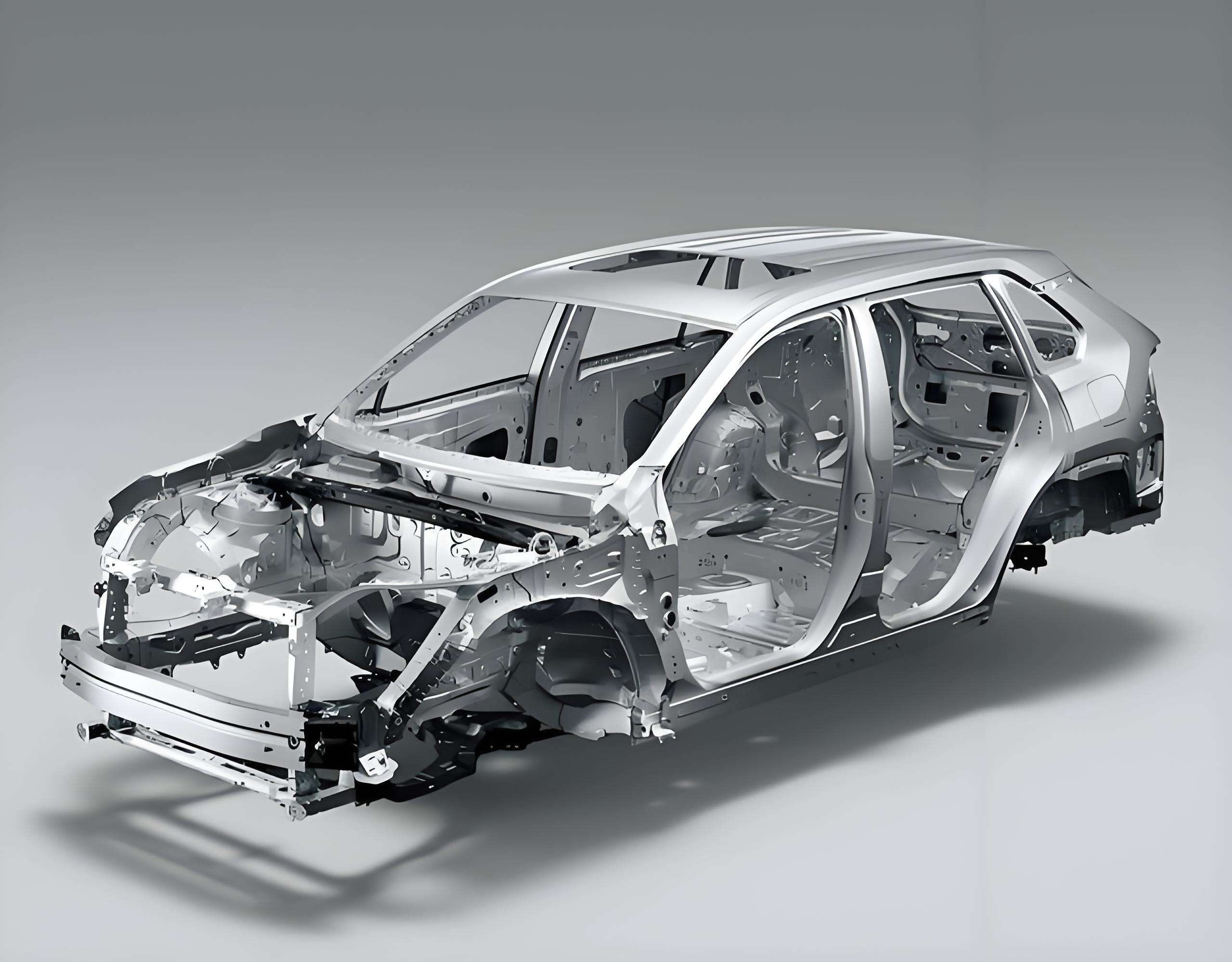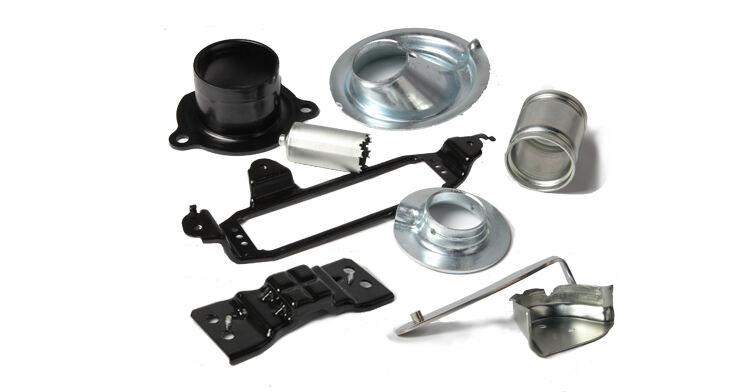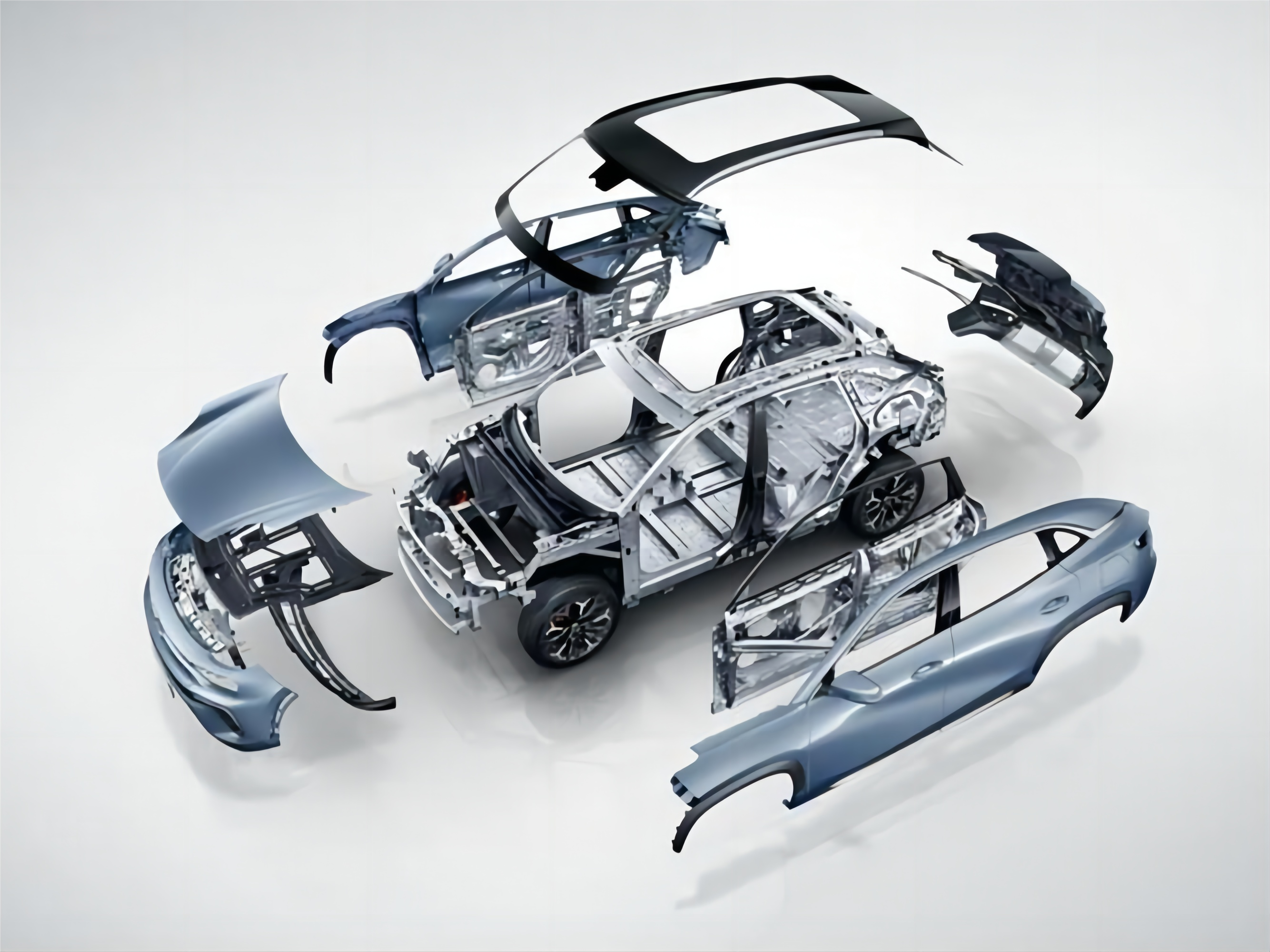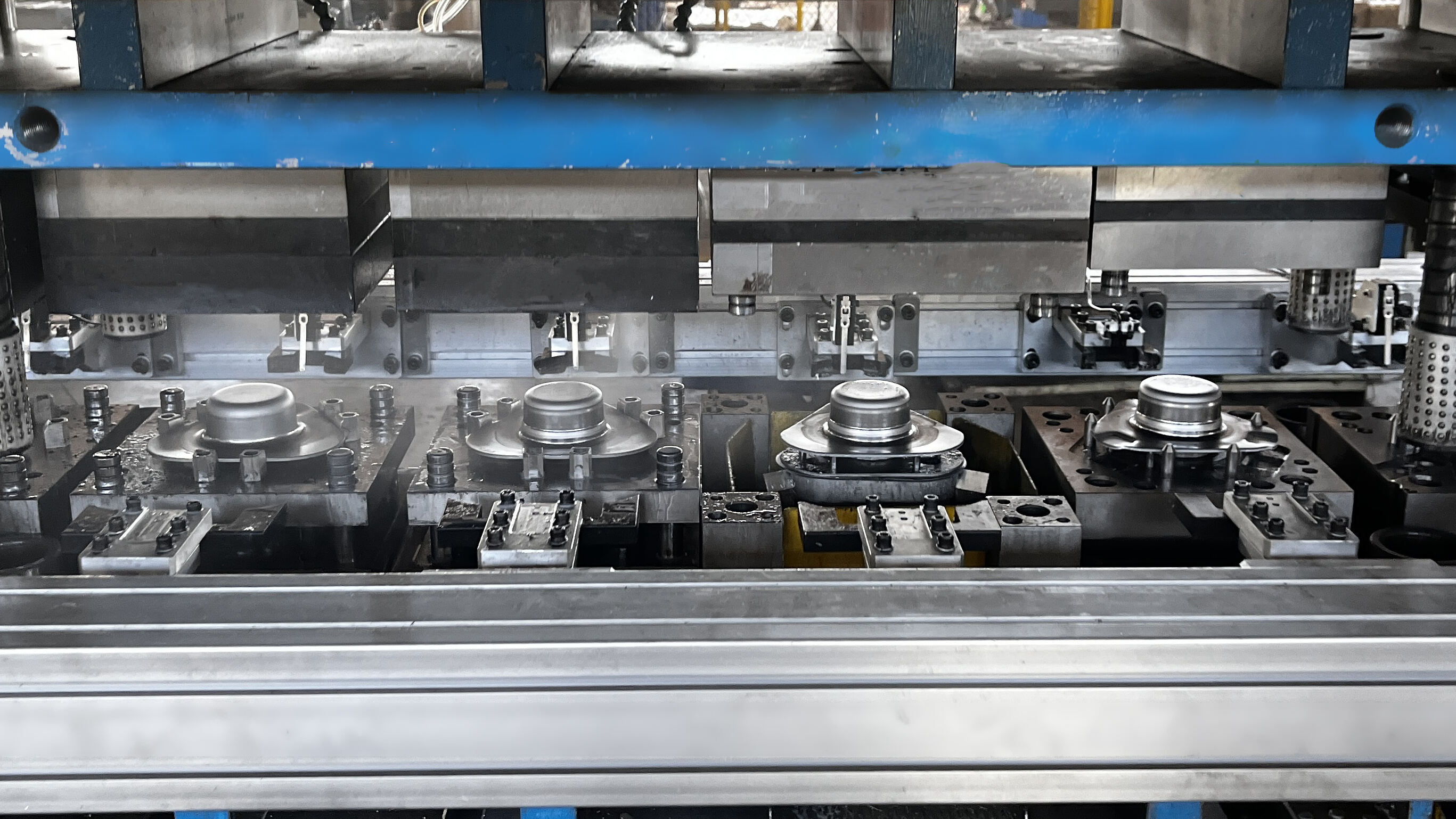Master Automotive Metal Stamping: Your Complete Overview
Introduction to Automotive Metal Stamping
Ever wondered how a flat sheet of metal becomes a car door, a hood, or even a tiny bracket hidden beneath your dashboard? That transformation happens through a process known as automotive metal stamping—a manufacturing cornerstone that turns raw metal into the precise parts every modern vehicle relies on.
At its core, automotive metal stamping is the process of converting flat metal sheets or coils into specific shapes and components using powerful presses and custom-designed dies. Imagine feeding a blank piece of steel into a machine and watching it emerge as a perfectly contoured fender or a complex engine bracket. This is not just about shaping metal; it’s about achieving accuracy, repeatability, and efficiency at scales that keep today’s automotive industry moving forward.
- Versatility: Metal stamping creates a vast range of automotive components, from large exterior panels like hoods and doors to intricate parts such as brackets, housings, and transmission gears.
- Precision: The process enables manufacturers to maintain tight tolerances, ensuring each part fits perfectly and performs reliably in the vehicle.
- Efficiency: Thanks to automation and high-speed machinery, stamping delivers high-volume production with consistent quality—vital for meeting the demands of the metal stamping automotive industry.
Why does this matter? Every stamped part—whether a visible body panel or a hidden structural support—contributes to the vehicle’s safety, performance, and aesthetics. Without metal stamping, producing cars at today’s speed and scale simply wouldn’t be possible.
In this comprehensive guide, you’ll discover:
- A step-by-step look at the automotive stamping process, from blanking to forming
- The key materials used and how they affect part performance
- Common types of stamped automotive parts and their applications
- How to choose the right supplier for your stamping needs
Whether you’re a manufacturing professional, an engineer, or simply curious about how cars are made, understanding automotive metal stamping gives you a window into the precision and innovation that drive the industry. Ready to dive in? Let’s explore how this essential process shapes the vehicles of today and tomorrow.

The Essential Role of Metal Stamping in the Automotive Sector
When you look at any modern vehicle, have you ever wondered what makes its structure both strong and lightweight, or how intricate designs come to life with such precision? The answer lies in the metal stamping automotive industry—a process that quietly shapes nearly every aspect of the cars we drive.
Why Is Metal Stamping Indispensable in Auto Manufacturing?
Let’s break down the core reasons why the automotive stamping process is at the heart of vehicle production:
- Vehicle Safety and Structural Integrity: Safety starts with a car’s skeleton. Stamped components like frame rails, cross-members, and reinforcements form the backbone of the vehicle, absorbing impact and protecting passengers in the event of a crash. Without the consistency of stamped parts, meeting stringent safety standards would be nearly impossible.
- Lightweighting for Fuel Efficiency: Imagine reducing a car’s weight without sacrificing strength. Metal stamping enables the use of advanced materials—such as high-strength steel and aluminum—and precise shaping to create thinner, lighter parts. This directly contributes to better fuel economy, lower emissions, and improved handling.
- Cost-Effective Mass Production: Need thousands of identical parts, fast? Stamping delivers. High-speed presses and automated feeding systems allow manufacturers to produce complex shapes at scale, dramatically lowering per-part costs. This efficiency is key to keeping vehicles affordable for consumers.
- Advanced Design and Aesthetics: Ever noticed the sleek lines or unique contours of a car’s body? Stamping gives designers the freedom to create intricate curves, sharp angles, and modern visual features—turning creative concepts into tangible parts that enhance both function and appearance.
How Metal Stamping Benefits Manufacturers and Drivers Alike
-
For Manufacturers:
- Streamlined production processes and reduced lead times
- Consistent quality and tight tolerances for every part
- Optimized material use, minimizing waste and cost
- Flexibility to adapt to new vehicle designs or technologies
-
For End Users:
- Safer vehicles thanks to robust, crashworthy structures
- Lower fuel costs and reduced environmental impact
- Attractive, modern car designs with flawless finishes
- Reliable performance and long-term durability
Sounds impressive? That’s because the automotive stamping process is more than just metal shaping—it’s a foundation for innovation, safety, and efficiency in every vehicle. As we move forward, let’s take a closer look at how raw metal is transformed into these critical parts, step by step.
A Breakdown of the Automotive Metal Stamping Process
Ever wondered how a flat piece of metal transforms into the sleek car panels you see on the road? The automotive metal stamping process is a fascinating journey that turns raw materials into precision-engineered parts essential for every vehicle. Let’s break down this process step by step, so you can see how each stage contributes to the strength, safety, and style of modern cars.
Understanding the Stamping Process in Car Manufacturing
Picture a giant press in a bustling factory, sheets of metal feeding through with rhythmic precision. That’s where the magic begins. The stamping process in car manufacturing is a series of carefully controlled steps, each designed to shape, cut, and refine metal into parts that fit perfectly and perform reliably. Here’s how it typically unfolds:
-
1. Blanking
Think of blanking as cutting cookies from dough. In this first step, a flat sheet or coil of metal is fed into a stamping press equipped with a blanking die. The die cuts out the basic outline—called a "blank"—for the part. Accuracy here is crucial, as this shape forms the foundation for all later stages. -
2. Piercing
Need holes or slots in your part? Piercing is the answer. Using specialized piercing dies, the press punches holes or cutouts exactly where needed—whether it’s for fasteners, wiring, or ventilation. This step ensures every bracket or panel is ready for assembly and function. -
3. Bending
Here, the blank is shaped into angles or curves. The press and a bending die work together to transform flat metal into three-dimensional forms. Imagine the gentle curve of a fender or the crisp edge of a door frame—these are made possible by precise bending operations. -
4. Forming/Drawing
Some parts need more complex shapes, like deep cavities or rounded contours. This is where forming and deep drawing come in. The metal is pressed into a die cavity, stretching and molding it into its final form. Think of a hood, a cup-shaped oil pan, or a boxy bracket—these all start as flat blanks and are drawn into shape. -
5. Trimming and Finishing
After forming, excess material is trimmed away for a clean, precise edge. Additional finishing steps—like deburring (removing sharp edges), cleaning, or applying protective coatings—prepare the part for assembly and long-term durability (source).
The Key Players: Dies and Presses
So, what makes all these steps possible? It’s a combination of dies and presses—the workhorses of the stamping world:
- Dies: These are custom-made tools, often from hardened steel, crafted to match the exact shape and features of the desired part. Each stage—blanking, piercing, bending, or forming—uses its own specialized die.
- Presses: The machines that deliver the force needed to shape metal. Mechanical presses are common for high-speed, high-volume production, while hydraulic presses are used for deep drawing or parts requiring greater force and control. Servo presses, with their programmable precision, are increasingly popular for complex or delicate operations.
Quality and Precision at Every Step
Throughout the automotive metal stamping process, quality control is constant. Operators monitor dimensions, inspect for defects, and ensure each part meets exacting standards. This attention to detail is why stamped parts fit together seamlessly and perform reliably, whether they’re body panels, brackets, or intricate engine components.
By now, you’ve seen how a simple metal sheet is transformed through a series of expert steps into the parts that make up your car. But what kinds of metals are best suited for this journey? Next, we’ll explore the key materials used in automotive stamping, and how their properties shape the final product.

Key Metals Used for Automotive Stamped Components
When you look at the variety of automotive stamped components in a vehicle, have you ever wondered what metals give them their strength, lightness, or resistance to harsh conditions? Selecting the right metal used for automotive stamping is a crucial decision that shapes everything from safety to fuel efficiency. But with so many options, how do manufacturers decide?
What Makes a Metal Ideal for Automotive Stamping?
Imagine you’re designing a car part—maybe a sturdy chassis bracket or a lightweight door panel. Your choice of metal isn’t just about cost; it’s about matching the unique properties of each material to the demands of the part. Let’s break down the most common metals used in automotive stamping and see how their characteristics fit different applications.
| Metal | Strength | Weight | Formability | Corrosion Resistance | Typical Automotive Applications |
|---|---|---|---|---|---|
| Steel (Mild, High-Strength Low-Alloy, Advanced High-Strength) | High (especially HSLA/AHSS) | Medium to High | Good (varies by grade) | Good (can be enhanced by treatment) | Body panels, chassis, structural supports, suspension, reinforcements |
| Aluminum Alloys | Moderate to High | Low (lightweight) | Excellent | Excellent | Hoods, doors, body panels, wheels, engine blocks, trim |
| Copper & Copper Alloys (Brass, Bronze) | Low to Moderate | Medium | Excellent (especially for thin or complex parts) | Excellent | Electrical connectors, wiring, terminals, heat exchangers |
| Magnesium Alloys | Moderate | Very Low (ultra-lightweight) | Good (can be cast into complex shapes) | Good | Chassis, doors, hoods, wheels (mainly in high-end or performance vehicles) |
| Titanium Alloys | Very High | Low | Fair (challenging to form) | Excellent | Brake rotors, exhaust systems, specialty racing parts |
| Iron & Iron Alloys | High | High | Fair | Good (when alloyed) | Engine blocks, frames, axles, gears, bearings |
Why These Metals?
- Steel—the workhorse of automotive stamping—offers a balance of strength, cost, and formability. High-strength low-alloy (HSLA) and advanced high-strength steels (AHSS) are especially valued for safety-critical parts and lightweighting without sacrificing durability.
- Aluminum is chosen when weight reduction is key, such as in electric vehicles or performance models. Its corrosion resistance and ease of forming make it ideal for panels and structural parts.
- Copper alloys excel in electrical and thermal applications—think wiring, connectors, and heat exchangers. Their softness allows for intricate, thin-walled shapes but limits their use in high-stress areas.
- Magnesium and titanium are specialty choices. Magnesium’s ultra-lightweight properties are prized in high-end vehicles, while titanium is used for parts needing extreme strength and corrosion resistance, like racing components.
- Iron and its alloys remain popular for heavy-duty applications, offering affordability and durability in engine and drivetrain parts.
How to Select the Right Metal?
Choosing the best metal used for automotive stamping means balancing several factors:
- Strength vs. Weight: Do you need maximum safety, or is lightweighting your top priority?
- Formability: Will the part require deep draws, sharp bends, or intricate shapes?
- Corrosion Resistance: Is the component exposed to harsh environments or chemicals?
- Cost and Availability: Does your budget allow for advanced alloys, or is standard steel sufficient?
- End Use: Will the part carry loads, conduct electricity, or simply add aesthetic value?
By understanding the unique strengths of each material, you’ll notice that automotive stamped components can be optimized for performance, durability, and cost. Next, let’s explore how these metals are transformed into the wide variety of parts found in every vehicle.
Common Types of Metal Stamped Automotive Parts
When you picture a car rolling off the assembly line, do you ever wonder which parts are shaped by stamping? The answer: more than you might think. From the largest exterior panels to the smallest interior brackets, automotive metal stamped parts are everywhere. Let’s break down the most common categories and see how the stamping automotive parts process shapes nearly every corner of a vehicle.
Body-in-White (BIW) Components
Imagine the skeleton of a car before paint, glass, or trim is added. That’s the body-in-white—an assembly of stamped metal parts welded together for strength, precision, and safety. BIW is the foundation for structural integrity and crashworthiness.
- Body panels: Doors, hoods, trunk lids, roof panels, quarter panels, and fenders
- Floor pans and firewalls: Large panels that form the base and firewall of the vehicle
- Roof rails and pillars: Vertical and horizontal supports that contribute to rollover protection
- Wheel housings: Curved panels that shield wheels and support suspension components
Structural and Chassis Parts
Think of these as the bones and joints of a vehicle, designed to handle stress, support weight, and keep everything aligned. Precision stamping ensures these parts are strong and consistent.
- Frame rails and cross-members: Core structural elements that support the vehicle’s weight
- Suspension brackets and mounts: Connect suspension arms, shocks, and control links
- Bumper reinforcement bars: Absorb impact and protect occupants during collisions
- Engine cradles and subframes: Support the engine and drivetrain within the chassis
Interior Supports and Functional Hardware
Peek beneath the surface, and you’ll find a network of stamped parts that make interiors safe, comfortable, and functional. These components are often hidden but play vital roles in everyday use.
- Seat frames and rails: Provide structure and adjustability for seats
- Brackets and mounting plates: Secure dashboards, consoles, airbags, and electronics
- Hinges and latches: Enable doors, trunks, and hoods to open and close smoothly
- Seat belt buckles and latches: Critical for occupant safety
Engine, Powertrain, and Under-the-Hood Elements
Stamped metal isn’t just for structure—it’s also essential for engine performance, cooling, and safety. Many under-the-hood parts are shaped for strength, heat resistance, and precise fit.
- Oil pans and transmission covers: Seal and protect vital fluids
- Battery cable connectors and ECU housings: Ensure reliable power and electronics management
- Heat shields and brackets: Protect sensitive components from engine heat
- Brake backing plates and radiator supports: Provide mounting and protection for critical systems
Why Are These Parts Stamped?
Stamped parts offer unmatched consistency, speed, and cost-effectiveness—especially when complex shapes or high volumes are required. Whether it’s a visible body panel or a hidden bracket, stamping delivers the precision and durability that modern vehicles demand.
As you explore a vehicle’s parts list, you’ll notice that stamped components touch every system—structural, mechanical, and even electronic. Next, let’s look at how standard parts differ from custom solutions, and why custom stamping is essential for unique designs or OEM requirements.
Understanding Custom Automotive Metal Stamping Solutions for OEM Precision
When you’re designing a new vehicle or upgrading a critical system, have you ever wondered why off-the-shelf stamped parts just won’t cut it? That’s where custom automotive metal stamping comes in—a tailored approach that delivers parts made to your exact specifications, rather than a one-size-fits-all solution.
Standard vs. Custom: What’s the Difference?
Standard stamped parts are produced in large quantities with fixed designs—think generic brackets or common fasteners. But what if you need a bracket that fits a unique chassis, a sensor housing with non-standard cutouts, or a structural element engineered for a new electric vehicle platform? Custom stamping is the answer. It’s all about making parts that match your drawings, tolerances, materials, and performance needs—no compromises.
| Standard Stamping | Custom Automotive Metal Stamping |
|---|---|
| Mass-produced, generic shapes | Designed specifically for your application |
| Limited material and finish options | Wide range of metals, finishes, and coatings |
| Minimal design flexibility | Supports unique geometries and tight tolerances |
| Lower upfront costs, but less optimization | Optimized for function, assembly, and lifecycle |
Why Custom Solutions Matter for OEMs
For OEM automotive sheet metal stamping projects, custom solutions aren’t just a luxury—they’re a necessity. Here’s why:
- Unique Designs: Each vehicle model brings new engineering challenges. Custom stamping allows for innovative shapes, specialized mounting points, and integration of advanced features.
- Performance Requirements: Safety-critical parts, lightweighting goals, or specific electrical/thermal needs often demand materials and designs not found in catalog parts.
- Brand Differentiation: Custom-stamped trim, badging, or interior supports help distinguish your vehicles in a crowded market.
Key Factors in Custom Automotive Metal Stamping
Sounds complex? Let’s break down the essentials that make a custom stamping project successful:
- Tooling: Custom dies and tooling are engineered to achieve your part’s exact shape, features, and tolerances. This upfront investment pays off with high repeatability and quality in production.
- Material Selection: The right metal—whether high-strength steel, aluminum, or specialty alloys—is chosen based on your performance, weight, and cost targets.
- Prototyping: Rapid prototyping and digital simulations let you test and refine designs before full-scale production, reducing risk and speeding up development cycles.
- Quality Assurance: Rigorous inspection, testing, and certification (such as ISO or IATF standards) ensure every part meets your requirements for safety and reliability.
The Value of an Expert Partner
Choosing the right specialist for custom automotive metal stamping can make all the difference. An experienced partner not only brings advanced equipment and engineering know-how, but also helps you navigate challenges like tight timelines, evolving designs, and stringent compliance needs.
"Collaboration and clear communication between automotive manufacturers and stamping providers are essential for overcoming obstacles and keeping projects on track."
If you’re looking for dependable, precision-driven solutions, it’s worth exploring high-quality Auto Stamping parts that offer robust engineering support, scalable production, and proven quality assurance. Custom stamping isn’t just about making a part—it’s about building a reliable, future-ready vehicle. Next, let’s see how you can identify top stamping companies to ensure your project’s success from concept to completion.

How to Identify Top Automotive Metal Stamping Companies
When you’re searching for the right automotive metal stamping companies to bring your project to life, do you ever wonder what separates a truly reliable partner from the rest? With so many options available, choosing the best automotive metal stamping supplier can feel overwhelming. Imagine the peace of mind that comes from knowing you’ve selected a partner who not only delivers quality parts but also supports your business goals at every stage.
Key Criteria for Evaluating Metal Stamping Suppliers
Sounds complex? Let’s simplify the process. Here’s a practical, step-by-step checklist you can use to assess any supplier. These criteria are drawn from industry best practices and real-world success stories:
| Evaluation Area | What to Look For | Why It Matters |
|---|---|---|
| Certifications & Compliance | IATF 16949, ISO 9001, environmental and safety standards | Proves commitment to quality, consistency, and industry requirements |
| Industry Experience | Years in business, relevant automotive project history | Shows ability to meet strict automotive standards and handle complex requirements |
| Technical Capabilities | In-house tooling, advanced machinery, engineering support | Enables precision, scalability, and faster turnaround times |
| Quality Control Processes | Statistical process control, CMMs, optical inspection, regular audits | Ensures parts meet tight tolerances and are free from defects |
| Prototyping & Design Support | Rapid prototyping, DFM analysis, collaborative design | Reduces risk, improves manufacturability, and shortens development cycles |
| Production Flexibility | Ability to handle small runs, high-volume orders, and scaling | Supports your changing needs as projects grow or shift |
| Value-Added Services | Assembly, finishing, secondary processing, logistics support | Simplifies your supply chain and ensures a finished, ready-to-use part |
| Communication & Transparency | Clear project updates, open pricing, responsive support | Builds trust and keeps projects on track |
| Track Record & Reputation | Client testimonials, portfolio of completed projects, case studies | Demonstrates reliability and consistent delivery |
How to Use This Checklist Effectively
- Review Certifications: Ask for documentation of IATF 16949 or ISO 9001. These indicate a supplier’s processes are audited and meet global automotive standards.
- Assess Technical Depth: Tour their facility (virtually or in person) to see equipment, in-house tooling, and engineering resources.
- Request Samples or Case Studies: Examine their previous work—like Auto Stamping parts—to gauge quality and complexity.
- Ask About Lead Times and Flexibility: Can they scale up quickly if your demand spikes? Are they transparent about delivery schedules?
- Evaluate Communication: Notice how promptly and clearly they respond to your questions. Good communication is often a sign of a reliable partner.
- Check References: Speak to current or past clients to confirm performance and reliability.
Why Supplier Portfolios Matter
Imagine you’re shortlisting suppliers and want proof of expertise. Reviewing a company’s portfolio—especially their range of Auto Stamping parts—lets you see their capabilities in action. Look for diversity in projects, consistent quality, and solutions for both standard and custom needs.
By following this checklist, you’ll notice it’s easier to filter out suppliers who lack the necessary rigor or technical depth. The next step? Weighing the pros and cons of sourcing from local versus global stamping suppliers. Let’s explore how location can impact your project’s cost, speed, and quality.
Evaluating Global and Local Stamping Suppliers
When you’re planning your next stamping project, do you find yourself weighing the benefits of working with a local supplier in the US versus a global partner in China? The decision isn’t always straightforward. Whether you’re focused on lowering costs, shortening lead times, or ensuring quality, understanding the trade-offs between automotive metal stamping China and automotive metal stamping US suppliers is essential for making the right call.
Key Factors to Consider in Supplier Selection
Imagine you’re launching a new vehicle model. You need precision-stamped parts, delivered on time, at a competitive price. But what matters more—upfront cost or long-term reliability? Let’s break down the most critical factors that influence your sourcing decision:
- Cost: What’s the true price per part, including hidden expenses?
- Lead Time: How quickly can your supplier deliver, especially when demand spikes?
- Logistics: What are the risks and costs of shipping, customs, and inventory management?
- Communication: Will you get fast, clear answers when issues arise?
- Quality Oversight: How easy is it to monitor production and resolve problems?
- IP Security: How safe is your proprietary design or tooling?
- Technology & Collaboration: Does your supplier offer advanced engineering support, rapid prototyping, or digital transparency?
Global vs. Local: A Side-by-Side Comparison
To help you visualize the trade-offs, here’s a practical table comparing key attributes of sourcing from US-based and China-based stamping suppliers, based on industry research and real-world experience:
| Factor | US Suppliers | China Suppliers |
|---|---|---|
| Upfront Cost per Part | Generally higher, but fewer hidden costs | Lower sticker price, but hidden costs (quality, logistics, tariffs) add up |
| Tooling & Die Quality | High durability; dies last longer, less downtime | Lower durability; more frequent repairs and part quality issues |
| Lead Time | Shorter, more predictable (domestic shipping) | Longer, variable (shipping, customs, global events) |
| Logistics & Shipping | Simpler, lower risk, lower emissions | Complex, higher risk (delays, port congestion, increased freight costs) |
| Communication | Easy, real-time, shared language & culture | Time zone and language barriers, slower response |
| Quality Oversight | Direct access for audits, faster troubleshooting | Difficult to monitor; travel required for onsite fixes |
| IP Security | Strong legal protections | Higher risk of IP leakage or unauthorized use |
| Access to Technology | Advanced engineering, digital transparency, rapid prototyping | Varies; may lack latest tech or collaborative tools |
| Sustainability & Community Impact | Supports local jobs, reduces carbon footprint | Higher emissions due to shipping, less local economic benefit |
Making the Best Sourcing Decision for Your Project
So, how do you decide? If your top priority is the lowest possible upfront cost and you’re comfortable managing complex logistics and quality risks, China-based suppliers might be appealing. But, as industry experts point out, the total cost of ownership often favors US-based suppliers when you factor in tooling longevity, communication, and risk mitigation. Local sourcing also supports sustainability and strengthens your supply chain’s resilience.
For many automotive projects—especially those requiring high precision, rapid design changes, or strict IP protection—partnering with a supplier that combines global reach with local service is ideal. That’s where one-stop solutions like Shaoyi’s Auto Stamping parts stand out. Their IATF 16949:2016 certification, advanced engineering support, and integrated production capabilities bridge the gap between cost, quality, and speed, helping you launch projects faster and with less risk.
Ultimately, the best choice depends on your unique priorities—cost, speed, quality, or supply chain security. Take time to weigh these factors, ask tough questions, and review supplier portfolios before making your decision. Up next, let’s look at the future of automotive metal stamping and how market trends are shaping sourcing strategies worldwide.

Navigating the Automotive Stamping Market Landscape
When you look ahead, do you wonder how shifts in technology, materials, and consumer demand are shaping the automotive metal stamping market? The landscape is evolving faster than ever, driven by new vehicle technologies, sustainability goals, and the relentless push for efficiency. Let’s break down the key automotive stamping trends that are defining the industry’s future—and what they mean for manufacturers, engineers, and buyers alike.
Key Market Drivers: What’s Fueling Growth?
- Rising Vehicle Production: The global automotive metal stamping market was valued at USD 86.5 billion in 2024 and is set to grow at a CAGR of 4.9% through 2030, propelled by increased demand for passenger cars and expanding manufacturing capabilities worldwide.
- Lightweighting & Fuel Efficiency: To meet stricter emissions standards and improve fuel economy, automakers are prioritizing lightweight materials—especially aluminum and advanced high-strength steels (AHSS)—in stamped parts.
- Electric Vehicle (EV) Revolution: The surge in EV production is transforming stamping requirements. EVs demand specialized components like battery enclosures and lightweight structural parts, pushing suppliers to innovate with new materials and processes.
Material Innovations: AHSS and Aluminum Lead the Way
- Advanced High-Strength Steels (AHSS): Imagine steel grades that are not only strong but also formable—making it possible to design thinner, lighter, yet safer vehicle structures. AHSS now includes over 65 commercial grades, with some cold and hot-stamped steels reaching tensile strengths near 2000 MPa. These materials are increasingly used in crash zones, seat rails, and body structures for both conventional and electric vehicles.
- Aluminum: Lightweight and corrosion-resistant, aluminum is essential for EVs and high-efficiency models. Its use in hoods, doors, and structural elements is rising, especially as manufacturers seek to offset the weight of batteries in electric vehicles (source).
Process & Technology Trends: Precision and Automation
- Industry 4.0 Integration: Stamping shops are adopting smart manufacturing technologies—automation, robotics, and AI-driven quality control—to boost productivity and consistency. For example, servo press technology allows for ultra-precise control over stroke and force, ideal for complex EV components and high-strength materials.
- Advanced Manufacturing Methods: Laser and hydraulic stamping, alongside high-tonnage presses, are enabling faster cycle times and greater flexibility. These innovations help manufacturers produce intricate parts with tight tolerances and minimal waste.
- Precision Stamping: As vehicles become more complex, the demand for highly accurate, repeatable parts is rising. This is especially true for EV connectors, battery components, and structural reinforcements, where even minor deviations can impact safety or performance.
Regional Dynamics: Where Is Growth Happening?
- Asia Pacific: Dominates the market with over 40% share in 2024, thanks to rapid industrialization, high vehicle demand, and investments in EV infrastructure—especially in China, Japan, and India.
- North America & Europe: These regions are investing in advanced stamping technologies and sustainable manufacturing, driven by government policies and a focus on innovation. The US, in particular, leads in R&D and high-value automotive production.
What’s Next for the Automotive Metal Stamping Market?
- Continued EV Growth: Expect further demand for lightweight, precisely stamped parts tailored to electric powertrains and battery systems.
- Material Evolution: Watch for the adoption of new AHSS grades and composite materials that balance strength, weight, and formability.
- Digital Transformation: More stamping companies are leveraging digital twins, simulation, and data analytics to optimize processes and predict maintenance needs.
By staying informed on these automotive stamping trends, you’ll be better equipped to navigate sourcing decisions, design challenges, and future-proof your automotive projects. In the final section, we’ll recap the essentials and offer guidance on leveraging these insights for your next stamping initiative.
Conclusion
Ever wondered what truly sets a high-performing vehicle apart? It’s the sum of countless expertly engineered parts—many of which are shaped by advanced automotive metal stamping solutions. As we wrap up this comprehensive overview, let’s revisit the essential insights that can help you make smarter decisions for your next project.
Why Metal Stamping Is at the Heart of Automotive Manufacturing
- Precision from Start to Finish: The stamping process transforms flat metal sheets into complex, high-strength components with unmatched accuracy and repeatability. From body panels to intricate brackets, this technology is the backbone of car manufacturing.
- Material Matters: Choosing the right metal—whether it’s advanced high-strength steel, lightweight aluminum, or specialty alloys—directly impacts part performance, safety, and cost. The best projects start with a clear understanding of each material’s strengths.
- Versatility and Customization: Whether you need standard parts or custom-engineered solutions for unique designs, today’s stamping technology supports both large-scale production and tailored, OEM-specific requirements.
- Supplier Selection Is Critical: Not all auto stamping parts suppliers are the same. Evaluating certifications, technical capabilities, and service portfolios ensures you partner with companies that deliver consistent quality, speed, and value.
- Global Trends Drive Innovation: The rise of electric vehicles, adoption of new materials, and integration of Industry 4.0 technologies are shaping the future of automotive metal stamping—demanding ever-greater precision and flexibility from suppliers.
Ready to Take the Next Step?
If you’re planning a new automotive project, imagine the confidence that comes from working with a trusted, certified partner—one who can deliver quality parts on time, support rapid development cycles, and simplify your entire supply chain. That’s the value of choosing a supplier with proven expertise in automotive metal stamping solutions.
- Quality Assurance: Look for partners with IATF 16949 certification and a robust quality control process.
- Integrated Services: Consider suppliers who offer everything from prototyping to mass production, including secondary processes and engineering support.
- Speed and Flexibility: Prioritize those who can accelerate your time-to-market and adapt quickly to design changes.
For a streamlined experience that checks all these boxes, explore the capabilities of Shaoyi’s Auto Stamping parts. Their one-stop approach, advanced engineering, and global track record make them a smart choice for projects where quality, speed, and reliability matter most.
As the automotive industry evolves, staying informed and partnering with the right experts will help you deliver safer, lighter, and more innovative vehicles. Use this guide as your roadmap—and take the next step with confidence, knowing you’re backed by the best in auto stamping parts supplier solutions.
Frequently Asked Questions about Automotive Metal Stamping
1. What are the four main types of metal stamping processes used in automotive manufacturing?
The four primary metal stamping processes in automotive applications are progressive die stamping, transfer die stamping, four-slide stamping, and fine blanking. Each method serves different part complexities and production volumes, with progressive die stamping ideal for high-volume, multi-step parts and fine blanking used for components needing precise, smooth edges.
2. What are automotive stampings and why are they crucial for vehicles?
Automotive stampings are metal parts formed from flat sheets using custom dies and presses. They are essential because they provide the structural integrity, safety, and precision required for body panels, chassis components, and intricate brackets, directly impacting vehicle performance and safety.
3. What are common problems encountered in automotive metal stamping?
Typical issues include cracks, wrinkles, folds, blanking burrs, uneven stretching, indentations, surface strains, and bursting. These defects can be minimized through careful die design, material selection, and rigorous quality control processes employed by certified suppliers.
4. How do you choose the right supplier for automotive metal stamping?
Selecting a top supplier involves evaluating certifications like IATF 16949, technical capabilities, in-house tooling, quality control, and the ability to provide prototyping and value-added services. Reviewing a supplier’s project portfolio and client references, such as those from Shaoyi, ensures proven expertise and reliability.
5. What metals are most commonly used for automotive stamped components?
Steel (including high-strength and advanced high-strength grades), aluminum alloys, copper alloys, magnesium, titanium, and iron alloys are widely used. The choice depends on required strength, weight, formability, and corrosion resistance for specific automotive applications.
 Small batches, high standards. Our rapid prototyping service makes validation faster and easier —
Small batches, high standards. Our rapid prototyping service makes validation faster and easier — 

